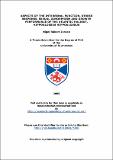Files in this item
Aspects of the interrenal function, stress response, sexual dimorphism and growth performance of the Atlantic halibut, Hippoglossus hippoglossus
Item metadata
| dc.contributor.advisor | Hazon, N. (Neil) | |
| dc.contributor.author | Jordan, Nigel Robert | |
| dc.coverage.spatial | 264 p. | en_US |
| dc.date.accessioned | 2015-08-18T14:59:15Z | |
| dc.date.available | 2015-08-18T14:59:15Z | |
| dc.date.issued | 2005 | |
| dc.identifier.uri | https://hdl.handle.net/10023/7280 | |
| dc.identifier.uri | uk.bl.ethos.526760 | |
| dc.description.abstract | Growth rates between individually tagged Atlantic halibut, from a single batch of farm produced eggs, on-grown in sea cages and pump ashore tanks for three years were significantly different. The tank reared fish 405g - 5992g showed a 29% premium in growth (final weight) compared to the cage reared fish 444g -4640g. Females in both systems reached a greater size (7352g tanks, 5836g cages) than males. Males that matured early (3819g tanks, 2877g cages) had a lower mean end weight than males maturing a year later (4326g tanks, 3086g cages). Early maturing males had the largest initial size. Seasonal variations in growth were observed for all groups. Major divergences in growth between males and females only became apparent when the males first matured at around 1.5 - 2 kg. No female maturation was observed during the trial. Halibut growth was determined to be positively allometric with growth of males being more linear then females. Condition factor increased with time whilst there was a decrease in Specific Growth Rate (SGR) from approximately 0.5%day⁻¹ to 0.1%day⁻¹ throughout the trial. Concentrations of plasma cortisol, osmolality, chloride and glucose measured through the trial provided no evidence of chronic stress at either site. Acute confinement stress (2, 12 and 30 minutes) was shown to elicit both primary and secondary stress responses in accordance with other marine teleosts. Increases in plasma cortisol, osmolality, CI⁻, Na⁺ and glucose were observed, reaching maximum concentrations within 80 minutes, although there was no effect on plasma K⁺. The duration of the confinement appeared to have no effect on the magnitude of the response. Following repeat confinements (4 days later) there was no evidence of either habituation or a cumulative effect in terms of cortisol or glucose whereas the effects on osmoregulatory function (Na⁺, CI⁻ and osmolality) appeared to be longer lasting. The results provided the first information regarding the stress response of the Atlantic halibut and enabled a better interpretation of the vales measured in the fish reared in tanks and cages (chapter 1). In vitro cortisol production (% above basal secretion), measured by radioimmunoassay, from perifused interrenal tissue of the Atlantic halibut was significantly stimulated by porcine adrenocorticotrophic hormone (ACTH) (0.01-1.0 μM) and [Asn¹, Val⁵] angiotensin II (All) (0.1-lO μm). No significant increase in cortisol production resulted from physiological levels of potassium (K⁺) although non-physiological levels (lOmMKl) did elicit a mild response in comparison to the effects of ACTH and All. Maximum steroid production was in response to 0.01μM ACTH (1351% above basal secretion) and 1.0μM All (397% above basal secretion). With increased concentrations above these levels of both ACTH and All there was a reduction in the degree of cortisol stimulation. The results show that the interrenal tissue of the Atlantic halibut responds in accordance to that of other teleosts to classical steroidogenic peptides. | en_US |
| dc.language.iso | en | en_US |
| dc.publisher | University of St Andrews | |
| dc.subject.lcc | QL638.P7J7 | |
| dc.subject.lcsh | Atlantic halibut -- Effect of stress on. | en_US |
| dc.subject.lcsh | Atlantic halibut -- Physiology. | en_US |
| dc.subject.lcsh | Atlantic halibut -- Growth. | en_US |
| dc.subject.lcsh | Interrenal gland -- Physiology. | en_US |
| dc.subject.lcsh | Sexual dimorphism (Animals) | en_US |
| dc.title | Aspects of the interrenal function, stress response, sexual dimorphism and growth performance of the Atlantic halibut, Hippoglossus hippoglossus | en_US |
| dc.type | Thesis | en_US |
| dc.type.qualificationlevel | Doctoral | en_US |
| dc.type.qualificationname | PhD Doctor of Philosophy | en_US |
| dc.publisher.institution | The University of St Andrews | en_US |
This item appears in the following Collection(s)
Items in the St Andrews Research Repository are protected by copyright, with all rights reserved, unless otherwise indicated.

